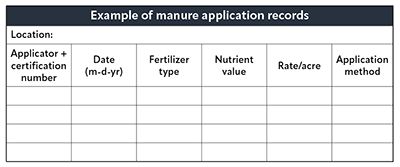The author is a Purdue University Extension educator based in Jasper County.

In the last 20 years, many states have added requirements for record keeping of manure applications on farm fields. This is to make sure that applications are used effectively as plant nutrients and to help protect water quality. Each state has different rules for applicator certification and record keeping, and some states are more stringent than others.
Starting in 2013, Indiana required anyone that applied over 10 cubic yards or 4,000 gallons of manure or fertilizer be certified as a licensed fertilizer material applicator. The applicator needs to take an initial exam, and then once they are certified, they can maintain their license by attending three recertification programs over a five-year period.
Along with record keeping, this new Indiana rule also included several good management practices, such as developing a fertilizer action plan prior to application and following that plan. Part of that plan includes manure testing so it is known what nutrients are actually being applied per acre. The plan also included restrictions on where manure can be applied, such as not directly on water and saturated ground, or not near setbacks from wells, sinkholes, and property lines. The fertilizer rule also put restrictions on manure applications applied to highly erodible land and frozen ground.
Write it down
One key part of this fertilizer rule is record keeping of manure applications. In Indiana, licensed fertilizer applicators are required to record the application within 30 days and to keep the records for two years after the application is made. Please check your state’s rules. For instance, in Ohio, the records need to be done within 24 hours after the application and kept for at least three years.

Manure application records in the Hoosier State must contain, at a minimum, the following:
1. Address or location description of the application site. This can be detailed or vague and could vary from being a GPS-generated application map to recording it as “Grandpa’s back 40.”
2. Name of the certified applicator making or supervising the application. If the applicator is not the certified applicator, it may be a good practice to also put the actual applicator’s name in the records for your own reference.
3. The applicator’s certification number.
4. Rate applied. This can be in tons per acre or gallons per acre.
5. Nutrient value of the fertilizer material. This requires a representative sample of the manure to be analyzed for its nutrient content. If purchasing the manure from another farm, make sure to have weight tickets and the analysis of the manure for your records. The manure analysis will be recorded as pounds of nutrient per 1,000 gallons or pounds of nutrient per ton.
6. Type of fertilizer used. Indicate if it is swine manure, dairy manure, poultry litter, or another source.
7. Method of application. Include details like broadcast, knifed in, variable rate, and so forth.
8. Date of application, including month, day, and year.
Indiana does not have a set form to fill out, but on the next page is an example of a form with columns for all the key information needed. Many states have a specific form to fill out for each application.
Extra information
Records of the slope of the field and how much residue is present at the time of the application could be useful information on areas with highly erodible soils or if the ground is frozen or snow covered.
When looking at other states’ requirements, several items on their required lists that need to be recorded could be very helpful to have recorded for reference in case there is a problem in the future. For example, many states require that you list the total acres covered and the total amount of product used for the field. The weather conditions, such as temperature, precipitation, and wind speed and direction the 24 hours before, during, and after the application are required in some states.
In Ohio, the records must contain the soil conditions during application, such as whether the soil is frozen or snow covered. In Nebraska, the records need to show the type of equipment used to do the application, date of calibration for spreading equipment, and days to incorporation of manure. Where the manure originated from and information for that farm is also on the records list.
Added benefits
Farms often keep records because they are required, but records can be very beneficial in the long run for other reasons, too, such as:
- They can aid in management decisions.
- They may provide liability protection.
- They could be used to justify insurance claims.
- They may be requested in real estate transfers.
- They could be included in a conservation plan.
Remember to check with your state annually to see what certifications you may need to apply manure. Also determine what records you must keep and how long to hold on to those records. These rules could change year to year.
This article appeared in the February 2023 issue of Journal of Nutrient Management on pages 20-21. Not a subscriber? Click to get the print magazine.




